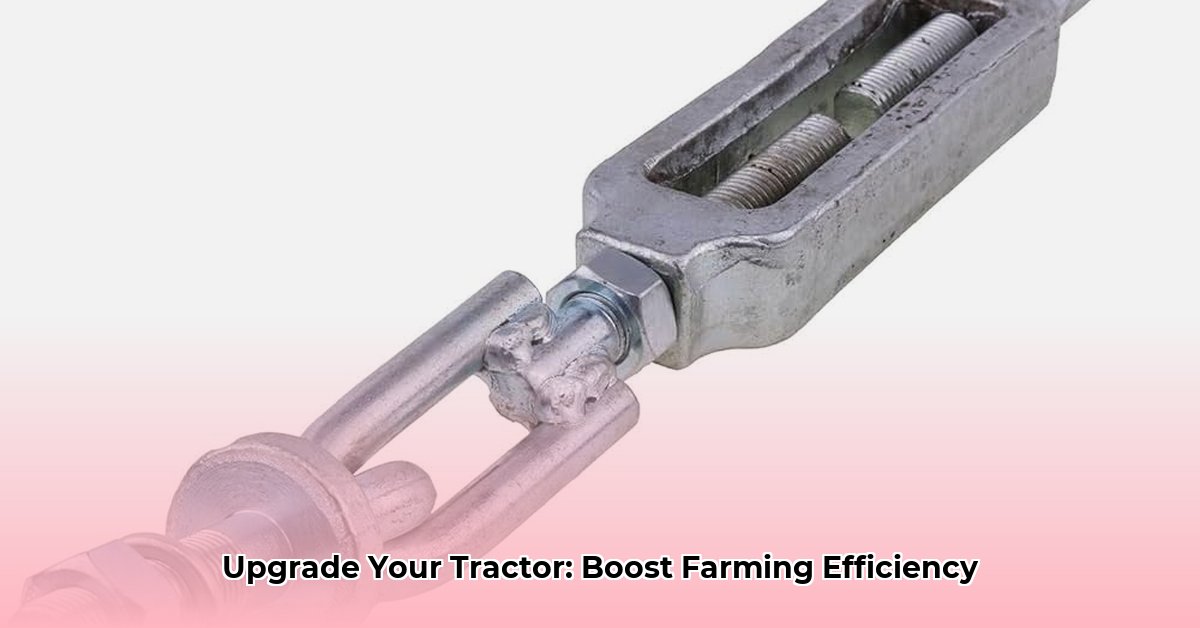
Choosing the right tools can significantly impact the efficiency and sustainability of your farm. Often overlooked, heavy-duty turnbuckles play a crucial role in maintaining the integrity and functionality of various farming equipment. This guide will equip you with the knowledge to select, install, and maintain the ideal turnbuckles, contributing to both a more productive and environmentally responsible operation. For more information on farm equipment maintenance, check out this helpful resource: Farm Equipment Guide. Imagine this: your irrigation system, vital to your sustainable practices, is failing due to loose connections. The resulting water waste and crop stress directly impact your yield and profitability. A robust, correctly chosen turnbuckle could have prevented this costly downtime.
Types of Turnbuckles: Material Matters
Several types of heavy-duty turnbuckles exist, each with unique strengths and weaknesses impacting their suitability and the overall environmental footprint of your operation.
Steel Turnbuckles: These are readily available and cost-effective. However, steel is susceptible to rust, particularly in humid or rainy regions. Regular maintenance is crucial, which can negate the initial cost savings. The positive side is that steel is easily recycled.
Stainless Steel Turnbuckles: Offering superior corrosion resistance, stainless steel turnbuckles boast a significantly longer lifespan than their steel counterparts. The higher upfront cost is often offset by their durability and reduced replacement needs. Stainless steel is also highly recyclable.
Aluminum Alloy Turnbuckles: These provide a lightweight yet relatively strong option, especially beneficial where weight is a significant consideration. They’re corrosion-resistant but generally less durable under heavy loads than steel. Aluminum is recyclable, but the process can be more complex than for steel.
The following table summarizes the key differences:
| Material | Advantages | Disadvantages | Recyclability | Sustainability Impact |
|---|---|---|---|---|
| Steel | Strong, affordable, readily available, easily recycled | Prone to rust, requires frequent maintenance | High | Moderate |
| Stainless Steel | Corrosion-resistant, long lifespan, highly recyclable | Higher initial cost | High | Excellent |
| Aluminum Alloy | Lightweight, corrosion-resistant, recyclable | Less durable than steel, potentially higher cost | High | Good |
Choosing the right material often involves balancing cost, durability, and environmental responsibility. Steel is the budget-friendly choice, but stainless steel delivers longevity, while aluminum offers a compromise.
Installation and Maintenance: A Practical Guide
Proper installation and regular maintenance are essential for safety and maximizing the lifespan of your turnbuckles. Always wear appropriate safety gear, including gloves and eye protection.
Step-by-Step Installation:
- Clean: Thoroughly clean all connection points and the turnbuckle itself to ensure a secure fit.
- Attach: Carefully attach the turnbuckle to the designated points, ensuring perfect alignment.
- Tension: Gradually adjust the turnbuckle to achieve the desired tension, avoiding over-tightening.
- Lubricate: Periodically lubricate the threads with an appropriate lubricant to reduce friction and wear.
- Inspect: Regular inspection for signs of damage (corrosion, bending, thread wear) is crucial. Replace damaged turnbuckles immediately.
Troubleshooting: Slippage or difficulty adjusting tension often indicates damage or misalignment. Inspect carefully and replace if necessary. Never force a damaged turnbuckle.
Choosing the Right Turnbuckle: A Decision Framework
Selecting the appropriate turnbuckle requires careful consideration of several factors:
- Load Capacity: Always choose a turnbuckle with a significantly higher load capacity than anticipated to ensure safety and longevity.
- Environmental Conditions: Harsh weather necessitates corrosion-resistant materials like stainless steel.
- Budget: Balance initial cost against long-term durability and replacement costs.
- Sustainability Goals: Prioritize recyclability and consider the entire lifecycle of the turnbuckle when making your selection.
Sustainability Considerations: Reducing Your Farm's Footprint
Sustainable farming practices encompass all aspects of the operation, including seemingly small details like turnbuckles.
- Lifecycle Assessment: Evaluate the environmental impact of each material from sourcing to disposal.
- Recyclability: Prioritize highly recyclable materials to minimize waste.
- Innovation: Explore emerging sustainable materials and manufacturing processes.
Investing in durable, recyclable turnbuckles contributes to a more sustainable and efficient farm operation. This seemingly small detail can significantly improve your farm's environmental profile.
Key Takeaways
Choosing the right heavy-duty turnbuckle is essential for efficient and sustainable farming. Careful consideration of material, load capacity, environmental factors, budget, and recyclability is crucial for informed decision-making. Prioritize proper installation and maintenance for optimal performance and longevity. By selecting durable and environmentally friendly turnbuckles, you contribute to both a profitable farm and a healthier planet.